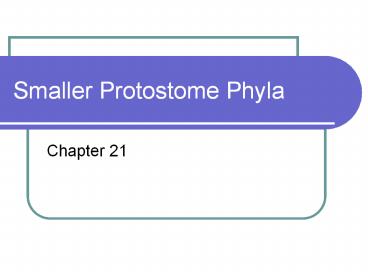Smaller Protostome Phyla - PowerPoint PPT Presentation
1 / 21
Title:
Smaller Protostome Phyla
Description:
Smaller Protostome Phyla Chapter 21 Small Coelomate Phyla Several small phyla of protostome coelomates include examples from superphyla Lophotrochozoa and Ecdysozoa ... – PowerPoint PPT presentation
Number of Views:228
Avg rating:3.0/5.0
Title: Smaller Protostome Phyla
1
Smaller Protostome Phyla
- Chapter 21
2
Small Coelomate Phyla
- Several small phyla of protostome coelomates
include examples from superphyla Lophotrochozoa
and Ecdysozoa - Lophotrochozoans
- Phylum Sipuncula
- Phylum Echiura
- Phylum Pogonophora
- Phylum Ectoprocta
- Phylum Brachiopoda
- Phylum Phoronida
3
Small Coelomate Phyla
- Sipuncula, Echiura, Pogonophora are similar in
many ways to annelids and molecular evidence
suggests that perhaps they should be included
within phylum Annelida.
4
Phylum Sipuncula
- Phylum Sipuncula consists of marine, benthic
worms that often live burrowed in the sand. - Retractable proboscis used for feeding.
- Deposit or suspension feeders.
- Trochophore larva
5
Phylum Echiura
- Phylum Echiura is another group of marine,
benthic worms that often live in the sediment. - Extend proboscis (cant be retracted) out to
pick up particles of detritus. - Trochophore larva
6
Phylum Pogonophora
- Phylum Pogonophora includes the tube-dwelling
vestimentiferan worms found at hydrothermal vent
systems. - No digestive tract most nutrition comes from
symbiotic chemoautotrophic bacteria that use
hydrogen sulfide to produce energy.
7
Lophophorates
- Phoronida, Ectoprocta, Brachiopoda are
seemingly different phyla that have several
characteristics in common. - Coelomate
- Protostome and deuterostome characteristics
- No distinct head
- Lophophore a unique arrangement of ciliated
tentacles on a ridge surrounding the mouth, but
not the anus.
8
Phylum Phoronida
- Species in the phylum Phoronida are small
wormlike animals. - Secrete tubes to live in.
- Tentacles of the lophophore are extended for
feeding. - U-shaped digestive tract.
9
Phylum Phoronida
- Characteristics of both protostomes
deuterostomes - Blastopore becomes mouth (protostome).
- Cleavage is radial (deuterostome).
- Coelom formation highly modified enterocoelous
(deuterostome).
10
Phylum Ectoprocta (Bryozoa)
- Bryozoans (phylum Ectoprocta) are aquatic, mostly
shallow water. - Mostly colonial.
- Fossils date to the Ordovician (505 mya).
- Complete digestive system.
- Mostly hermaphroditic.
11
Phylum Ectoprocta (Bryozoa)
- Characteristics of both protostomes
deuterostomes - Cleavage is radial (deuterostome) but determinate
(protostome).
12
Phylum Brachiopoda
- Brachiopods appear similar to bivalve molluscs
because they have two calcareous shell valves
secreted by a mantle. - Dorsal/ventral instead of left/right.
- Pedicel a fleshy stalk used for attachment.
13
Phylum Brachiopoda
- Brachiopods are an ancient group they were
prolific during the Paleozoic and Mesozoic eras. - One living species, Lingula, is considered to be
a living fossil since it has changed little since
the Ordovician (505 mya).
14
Phylum Brachiopoda
- Characteristics of both protostomes
deuterostomes - Cleavage is radial (deuterostome)
- Coelom formation enterocoelous at least in some
brachiopods. (deuterostome) - The relationship of the blastopore to the mouth
is uncertain.
15
Small Ecdysozoan Phyla
- Some of the phyla within the Ecdysozoa are very
closely related to the arthropods. - Phylum Onychophora
- Phylum Tardigrada
- Phylum Chaetognatha
16
Phylum Onychophora
- Velvet worms (phylum Onychophora) are nocturnal
caterpillar-like animals that have changed little
over 500 million years.
17
Phylum Tardigrada
- Tardigrades, or water bears, are less than a
millimeter in length. - Freshwater or marine
- Live in spaces between sand grains.
- Tardigrade clips
18
Phylum Tardigrada
- They share many characteristics with arthropods.
- But legs are unjointed.
- Non-chitinous cuticle that is molted.
19
Phylum Tardigrada
- Tardigrades can enter a state called
cryptobiosis, where metabolism is imperceptible. - In this state, they can withstand harsh
conditions - Extreme low temps
- Desiccation
20
Phylum Chaetognatha
- The arrow worms, phylum Chaetognatha, are all
marine, planktonic organisms. - Some deuterostome embryological characters.
- Molecular works suggests they are protostomes.
21
Phylogeny
- Sipunculans, echiurans and annelids are probably
very closely related. - Placement of phorids, brachiopods, and ectoprocts
is difficult due to the mixture of protostome and
deuterostome characteristics.































